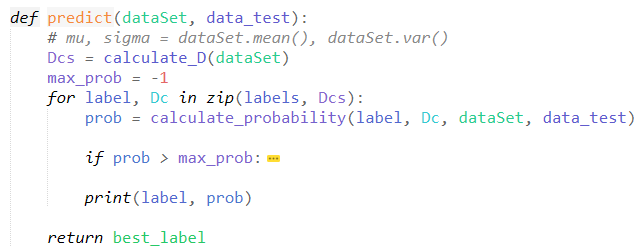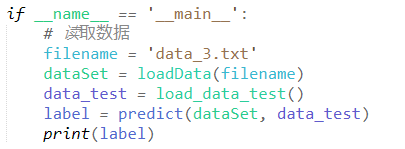Machine Learning (Zhou Zhihua) Watermelon Book Chapter 7 Exercise 7.3-Python Implementation
-
Experimental topics
Laplacian modified naive Bayesian classifier is implemented by trial programming. The watermelon data set 3.0A is used as training set to discriminate P.151 "test 1" samples.
-
Experimental principle
Laplacian correction avoids the problem that the probability estimate is zero due to insufficient training set samples.
Naive Bayesian classifier:

Naive Bayesian Classifier Expressions

Laplace's revised prior-like probability formula

Laplacian modified conditional probability formula for discrete attributes

Conditional probability formula for continuous attributes

-
Experimental process
Data Set Acquisition
Get the watermelon data set 3.0A in the book and coexist as data_3 a.txt
Density, sugar content, melon 0.6970000000000001, 0.46, yes 0.774, 0.376, yes 0.634, 0.264, yes 0.608, 0.318, yes 0.556, 0.215, yes 0.4029999999999999997, 0.237, yes 0.48100000000004,0.149, 0.43700000000006,0.21100000000000002 0.665999999999999999, 0.091, no 0.243, 0.267, no 0.245, 0.057, no 0.3429999999999999997, 0.099, no 0.639, 0.161, no 0.657, 0.198, no 0.36, 0.37, no 0.593, 0.042, no 0.7190000000000001, 0.10300000000000001, no
Algorithm implementation
Data Definition, Defining Attributes and Their Value Categories, Class Label Categories

Read data function

Generating prediction data

Generate a set of samples of different label classes by label class

Computing Class Prior Probability

Computing Conditional Probability of Discrete Attributes

Computing Conditional Probability of Continuous Attributes

Calculate the probabilistic reliability of determining the test sample as label

Predictive test sample labeling

main function, calling the above function

-
experimental result

-
List of procedures:
import math
import numpy as np
import pandas as pd
D_keys = {
'Color and lustre': ['Dark green', 'Jet black', 'plain'],
'Pedicle': ['Curl up', 'Stiff', 'Curl up'],
'stroke': ['Crisp and crisp', 'Dreary', 'Voiced sound'],
'texture': ['Slightly paste', 'vague', 'clear'],
'Umbilicus': ['Sunken', 'Slightly concave', 'flat'],
'Touch': ['Soft sticky', 'Hard slip'],
}
Class, labels = 'Good melon', ['yes', 'no']
# Read data
def loadData(filename):
dataSet = pd.read_csv(filename)
dataSet.drop(columns=['number'], inplace=True)
return dataSet
# Configuration Test 1 Data
def load_data_test():
array = ['Dark green', 'Curl up', 'Voiced sound', 'clear', 'Sunken', 'Hard slip', 0.697, 0.460, '']
dic = {a: b for a, b in zip(dataSet.columns, array)}
return dic
def calculate_D(dataSet):
D = []
for label in labels:
temp = dataSet.loc[dataSet[Class]==label]
D.append(temp)
return D
def calculate_Pc(Dc, D):
D_size = D.shape[0]
Dc_size = Dc.shape[0]
N = len(labels)
return (Dc_size+1) / (D_size+N)
def calculate_Pcx_D(key, value, Dc):
Dc_size = Dc.shape[0]
Dcx_size = Dc[key].value_counts()[value]
Ni = len(D_keys[key])
return (Dcx_size+1) / (Dc_size+Ni)
def calculate_Pcx_C(key, value, Dc):
mean, var = Dc[key].mean(), Dc[key].var()
exponent = math.exp(-(math.pow(value-mean, 2) / (2*var)))
return (1 / (math.sqrt(2*math.pi*var)) * exponent)
def calculate_probability(label, Dc, dataSet, data_test):
prob = calculate_Pc(Dc, dataSet)
for key in Dc.columns[:-1]:
value = data_test[key]
if key in D_keys:
prob *= calculate_Pcx_D(key, value, Dc)
else:
prob *= calculate_Pcx_C(key, value, Dc)
return prob
def predict(dataSet, data_test):
# mu, sigma = dataSet.mean(), dataSet.var()
Dcs = calculate_D(dataSet)
max_prob = -1
for label, Dc in zip(labels, Dcs):
prob = calculate_probability(label, Dc, dataSet, data_test)
if prob > max_prob:
best_label = label
max_prob = prob
print(label, prob)
return best_label
if __name__ == '__main__':
# Read data
filename = 'data_3.txt'
dataSet = loadData(filename)
data_test = load_data_test()
label = predict(dataSet, data_test)
print('Forecast results:', label)